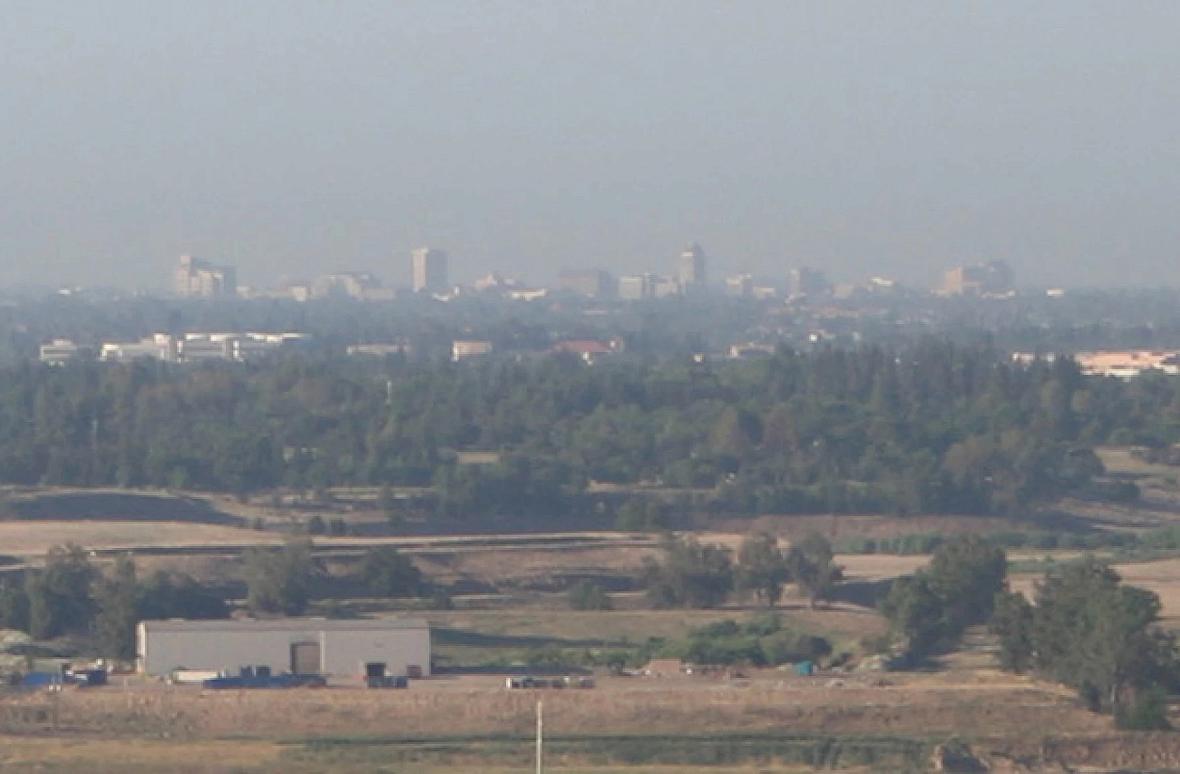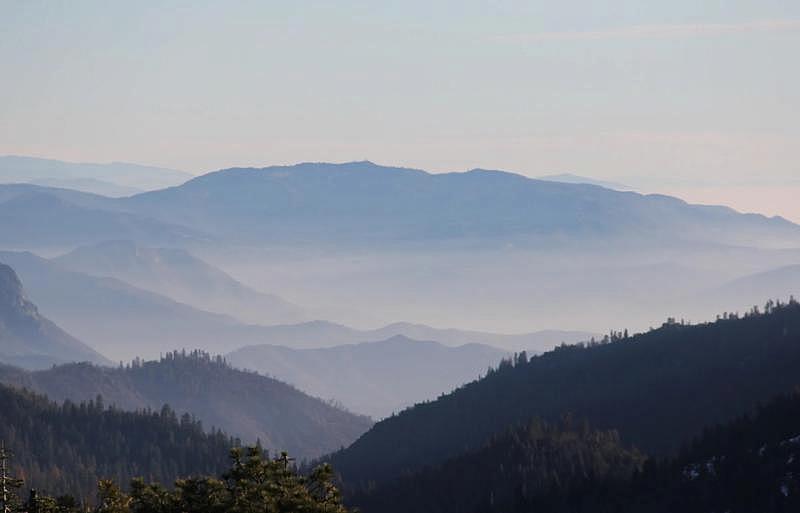With little confidence in California air quality regulators, advocates turn to Biden-Harris
This is part of the series When the Smoke Clears, produced with the support of the USC Annenberg Center for Health Journalism Impact Fund.
Other stories in this project include:
After ‘decades of broken promises’ will Valley air regulators finally end ag burning?
Smoke from ag burning contributes to long-term health effects for Valley Latino residents
As air regulators phase out ag burning, what’s the alternative?
‘What am I going to do?’ Small growers especially apprehensive of a future without burning
A political fight and the legal ‘loophole’ that’s polluted the San Joaquin Valley for 20 years

The San Joaquin Valley is the only region in the country to be out of compliance with 1997 federal air quality standards.
Joe Moore / KVPR
This is part of the series When the Smoke Clears, produced with the support of the USC Annenberg Center for Health Journalism Impact Fund.
Clean air advocates in the San Joaquin Valley are calling on the Biden-Harris Administration to intervene in the Valley’s air pollution health hazard as an environmental justice priority. They want the administration to require California regulators to strengthen regulations and reduce emissions from polluting industries.
The Valley for years has been severely out of compliance with federal clean air standards, and the American Lung Association has identified Valley cities among the most polluted in the country for years.
The region remains the only air basin in the United States that hasn’t met the 1997 annual national air quality standard for particulate matter known as PM 2.5. It’s a standard that has since become even more strict as scientific research links exposure to PM 2.5 to serious health problems. The Valley is also out of compliance with 2006 and 2012 standards.
An estimated average of 1,200 people a year died prematurely from exposure to elevated levels of PM 2.5 in the Valley, according to 2014 to 2016 data from the California Air Resources Board.
The U.S. Environmental Protection Agency has the authority under the Clean Air Act to intervene in local and state strategies to bring them into compliance with federal standards. A judge recently found the state’s plan to come into compliance is unfeasible because it heavily relies on incentives to reduce emissions, yet the program has a $2.6 billion shortfall.
Valley residents and public health advocates, as well as conservation and environmental organizations, have lost confidence that local and state regulators will strengthen and enforce regulations to reign in emissions from polluters and protect public health. They point to the decades-long delay in prohibiting agricultural burning as an example of failure to act.
“One in four children in the Valley have asthma. This is a public health crisis. This is a climate crisis. And they’ve turned a blind eye to the Valley,” Neal Desai, a senior program director with the National Parks Conservation Association (NPCA), said of state and local air quality regulators. “This is embarrassing because California is supposed to be leading on these issues.”
Poor air quality in the Valley disproportionately impacts people of color. More than half its residents identify as Hispanic or Latino, and one-fifth of the population lives below the federal poverty rate.
Desai points to the Biden-Harris Administration’s explicit interest in prioritizing environmental justice for disadvantaged communities as an opportunity. The administration recently created a White House Environmental Justice Advisory Council and promoted investment in infrastructure and programs for cleaner water and cleaner air under the Justice40 Initiative.
“We have the worst air quality in the nation. We are now looking to hold our federal leaders accountable for their word because the state and local governments have completely failed the Valley,” Desai said. “They’re the regulator of last resort.”
Pollution that originates in the Valley can travel to downwind communities, including into the Sierra Nevada mountains. That’s why air quality issues like agricultural burning attracted the interest of the National Parks Conservation Association.

“That pollution heads up into some of the most iconic national parks in the country: Yosemite,
Sequoia and Kings Canyon,” Desai said. “If we want to ensure these places are protected, that when you actually go there, you can get clear views, the scenic views that people expect… If folks want to be able to get out and actually recreate, walk around and not feel like it can trigger an asthma attack, then we need to clean up the air right here in the San Joaquin Valley.”
Advocates are now pinning their hopes on a lawsuit from 2021 that could trigger the EPA to require state and local regulators to enact stronger rules and regulations to reduce pollution.
Federal agency could push for stricter regulations
That advocates would turn to the EPA to help clean up the Valley’s air quality is a Hail Mary.
The federal agency has had authority under the Clean Air Act to bring the San Joaquin Valley Air Pollution Control District into compliance with air quality standards for decades. They have not taken action to do so.
The NPCA just won a legal battle against the federal agency on the issue — and advocates are hoping the EPA under the new administration will reevaluate its approach to Valley air and intervene more directly in regulatory issues.
In 2021, the NPCA along with the Central California Environmental Justice Network, Sierra Club and local health and resident groups sued the Environmental Protection Agency for approving a plan by the air district and the California Air Resources Control Board to come into compliance with national air quality standards that they considered seriously inadequate.
They argued that the EPA’s approval was arbitrary and capricious, in part because the plan’s commitments didn’t actually satisfy requirements of clean air rules. It relied too much on underfunded incentive-based strategies to reduce emissions, instead of strengthening rules and regulations and enhancing enforcement efforts.
A federal appellate court judge agreed with part of their argument. The judge ruled that the EPA erred in concluding that the state is capable of fulfilling its commitment to reduce particulate matter pollution, “because California is unable to adequately fund the Plan’s incentive-based control measures.”
Regardless of funding shortfalls, the EPA had also concluded the air district would still be able to meet its air quality improvement goals. The judge declared that, too, was erroneous, and directed the federal agency to fix the problems with the plan.
Now, there are two ways the federal agency can move forward, according to Mark Rose, Sierra Nevada Program Manager with the NPCA.
“Either EPA can kind of push around some papers, mess with their modeling and come up with a technical excuse for why they think the state could meet that,” Rose said. “Or, they can actually dig down deep and look at what additional measures can be put in place to make up for this massive gap in emissions that we need to reduce in the coming years.”
Rose said regulators and the EPA need to start listening to community members and advocates who for years have called for “a suite of additional measures” beyond the incentive-heavy strategy that the air district has been relying on for so many years.
Those include increased restrictions on household burning and closing loopholes related to oil and gas extraction. Many also call for stricter regulations on the agricultural industry, including tighter emissions rules for ag equipment and more strategies for addressing nitrogen-based fertilizers.
Ultimately, Rose said he hopes Biden will “just pay attention to us.”
“This is an environmental emergency that is predominantly impacting people of color who’ve been left behind for decades,” he said. “Give us more resources. Give us more attention. Because this could be a major victory. If you can get the Valley into attainment with federal Clean Air Act requirements, that would be a major victory for his environmental justice agenda.”
Monica Vaughan can be reached at monicalvaughan@gmail.com or on Twitter @MonicaLVaughan. Kerry Klein can be reached at kerry@kvpr.org or on Twitter @EineKleineKerry.
[This article was originally published by KVPR.]
Did you like this story? Your support means a lot! Your tax-deductible donation will advance our mission of supporting journalism as a catalyst for change.


